If you have undergone a nose surgery but the result was not as expected, revision rhinoplasty may be the ideal solution. However, this procedure is more complex than the first one, so it is important to research carefully and choose a trusted clinic. In Vietnam, this service is becoming increasingly popular among international visitors thanks to advanced technology, reasonable costs, and premium care quality. In this article, we will explore when revision rhinoplasty is needed, its benefits, procedure, recovery tips, and reputable clinics for your peace of mind.
What Is revision rhinoplasty?
Revision rhinoplasty is an advanced cosmetic procedure designed to correct undesired results from a previous nose surgery. Common issues include a crooked nose, irregular bridge, red or shiny nasal tip, tip retraction, breathing difficulties caused by a deviated septum, or deformities due to infection.
Unlike primary rhinoplasty, revision surgery requires the surgeon to remove old scar tissue and use autologous cartilage grafts (usually from the septum, ear, or rib) to rebuild a stable structure. In Vietnam, a popular approach is structural revision rhinoplasty combined with endoscopic techniques, which helps minimize trauma and create a natural, balanced, and long-lasting nose shape.
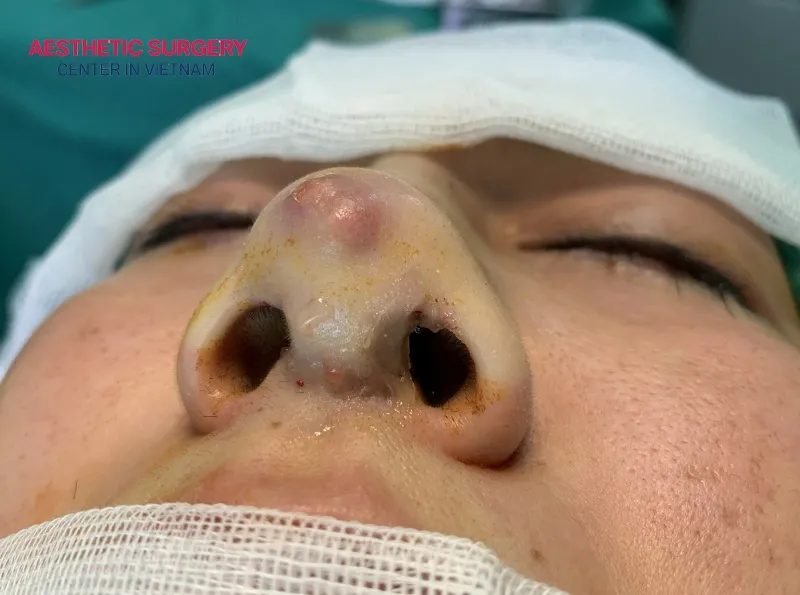
When should you get revision rhinoplasty?
You should consider revision rhinoplasty if you notice one or more clear signs at least 6–12 months after your previous nose surgery. This period is necessary for the tissue to fully stabilize.
Look out for abnormal features such as:
- Crooked or bent nose, irregular or bumpy bridge.
- Red, shiny, or retracted tip, exposed cartilage or silicone.
- Asymmetrical nostrils, upturned or small nostrils.
- Breathing difficulties on one or both sides due to a deviated septum, weak cartilage, or displaced grafts.
- Loud snoring or recurrent sinus infections caused by a damaged nasal structure.
- Prolonged infection or exposed implants.
- Nasal tip necrosis or septal perforation.
In Vietnam, surgeons usually recommend waiting at least 6 months for minor cosmetic corrections and 12 months if large cartilage grafts or full structural reconstruction is needed. Consult your surgeon to choose the right timing for revision rhinoplasty. Don’t rush—a well-timed revision can prevent a third surgery. But don’t wait too long either, as scar tissue can make the procedure more difficult and the results less natural.

Benefits of revision rhinoplasty
Revision rhinoplasty offers outstanding benefits both aesthetically and functionally, helping you restore a harmonious face and natural confidence.
First, this procedure completely corrects defects such as a crooked nose, retracted tip, bumpy bridge, or exposed implants, creating a high, natural nose with soft contours that suit every angle of your face.
At the same time, reconstructing the structure with autologous cartilage also improves breathing, reducing issues like nasal obstruction, snoring, or recurrent sinus infections. Moreover, in Vietnam, 3D endoscopic technology combined with local anesthesia helps minimize pain, limit scarring, and shorten recovery to just 5–7 days of swelling.

How much does revision rhinoplasty cost?
As a smart choice for international visitors, revision rhinoplasty in Vietnam offers not only high quality but also significant savings compared to Western countries.
The cost of revision rhinoplasty in Vietnam usually ranges from 40–120 million VND (approximately 1,600–4,800 USD), detailed as follows:
| Type of surgery | Description | Estimated cost (VND) | Estimated cost (USD) |
| Minor revision | Corrects tip, asymmetrical nostrils, no large cartilage graft needed | 40–60 million | 1.600 – 2.400 |
| Moderate structural revision | Treats scar tissue, grafts cartilage from ear/septum, corrects deviated septum | 60 – 90 million | 2.400 – 3.600 |
| Major revision | Full reconstruction, rib cartilage graft, 3D endoscopic technique | 90 – 120 million | 3.600 – 4.800 |
The cost of revision rhinoplasty in Vietnam includes consultation fees, anesthesia, post-operative medication, and 1–3 months of follow-up. Besides the complexity of the surgery, the price is also affected by several factors, such as:
- Surgeon and clinic: The higher the surgeon’s skill and experience, and the more advanced the clinic’s facilities and technology, the higher the cost.
- Materials: Autologous cartilage is safer and long-lasting but more expensive than synthetic implants.
The Revision Rhinoplasty Procedure
Revision rhinoplasty is a standardized and personalized procedure based on each nose condition. It usually lasts 2–4 hours under general anesthesia. The procedure follows international standards, combining 3D endoscopy and structural techniques to ensure safety and precision. Below are the detailed steps:
Step 1. Examination & consultation (1–2 sessions)
- The surgeon examines the old nose using endoscopy and 3D CT scan to assess scar tissue, deviated septum, and weak cartilage.
- A surgical plan is made: graft type (ear/rib cartilage), method (open rhinoplasty/closed rhinoplasty), and desired nose shape.
Step 2. Testing & preparation (1–2 days before)
- Blood tests, cardiac check, and allergy tests.
- Stop smoking, alcohol, and aspirin 2 weeks before surgery to reduce swelling and bleeding.
Step 3. Anesthesia & disinfection
- General anesthesia (safe for international patients). The nose, ear, or rib areas are disinfected thoroughly.
Step 4. Removal of old materials
Remove exposed silicone, damaged implants, and fibrotic tissue through a closed incision (inside the nostrils) or an open incision (under the columella for severe cases).
Step 5. Nasal structure reconstruction
- Correct deviated septum and improve airway.
- Use autologous cartilage grafts (septal → nasal bridge; ear → tip; rib → severe cases).
- Reshape the nasal tip and alar with absorbable sutures.
Step 6. Wound closure & fixation
- Suture aesthetically with 6.0–7.0 thread, place a thermoplastic splint for 5–7 days, and apply compression to reduce swelling.
Step 7. Postoperative care (24–48 hours)
- Patients stay overnight for monitoring, antibiotics, and pain control.
- Surgeons provide wound care and cold compress instructions to reduce pain.
In Vietnam, the revision rhinoplasty process often combines laser swelling reduction and a 4K endoscopic system, allowing precise manipulation and minimal tissue damage. The entire procedure is recorded for you to review and compare before and after.
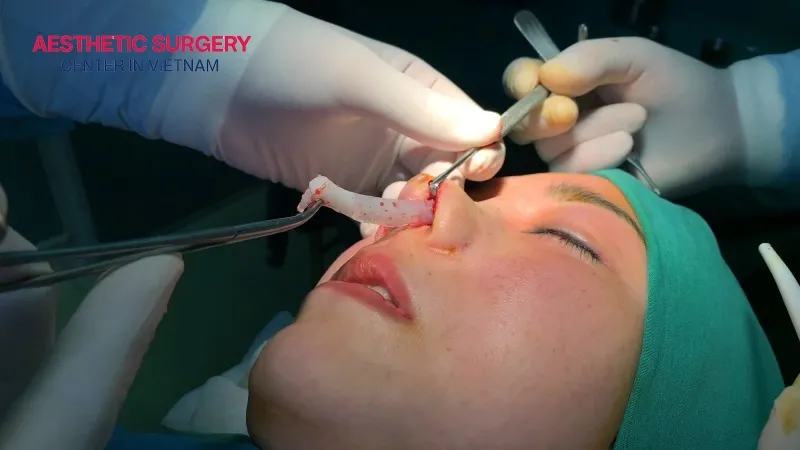
Is revision rhinoplasty painful?
Revision rhinoplasty usually causes no significant pain during the procedure thanks to modern general anesthesia, allowing you to sleep deeply for 2–4 hours without feeling anything.
After waking up, you may feel mild to moderate discomfort (level 3–5/10) mainly around the nose, forehead, or cartilage donor areas (ear/rib). However, there is no need to worry, as this pain can be fully controlled with prescribed pain medication.
Most patients only need oral painkillers and anti-inflammatory drugs for the first 3–5 days, after which they experience only slight soreness.
In Vietnam, reputable clinics apply a multimodal pain management protocol (combining cold compress, anti-inflammatory laser, and smart compression bandage), which helps reduce swelling and pain by up to 50% compared to older techniques.
You can resume light activities after 48 hours and sleep comfortably without pain if you follow the post-op instructions.
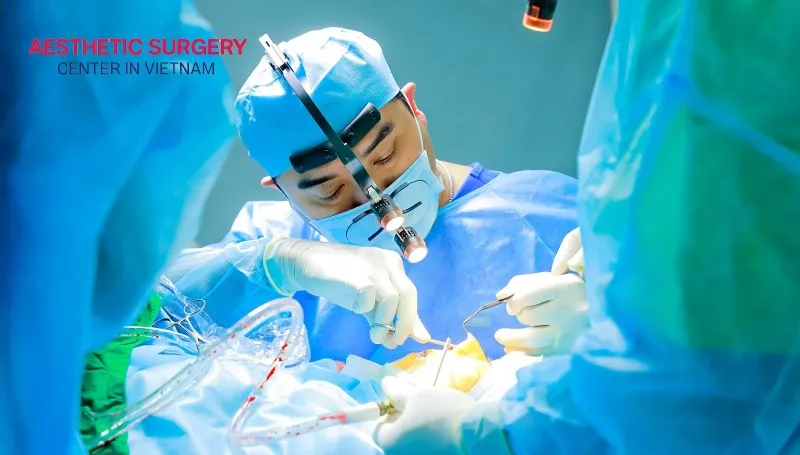
Does revision rhinoplasty leave scars?
Revision rhinoplasty may leave scars, but they are usually very small and almost invisible when performed with proper technique. With the endoscopic (closed) method, which accounts for 70–80% of cases in Vietnam, all surgical steps are done inside the nostrils without any external skin incision, leaving no visible scars.
For severe cases that require an open approach, the surgeon makes a tiny incision (3–5 mm) under the columella, closes it with fine 7.0 aesthetic sutures and microsurgical technique. The scar is as thin as a hair, fades within 3–6 months, and becomes completely hidden in the natural crease.
When combined with Fractional CO2 laser treatment, the scar can become unnoticeable after one year. Less than 2% of patients may develop hypertrophic scars due to their skin condition, but this can be treated with steroid injections or silicone gel.
To achieve a beautiful nose without visible surgical traces, it is important to choose an experienced surgeon, a reputable aesthetic clinic, and follow proper aftercare.
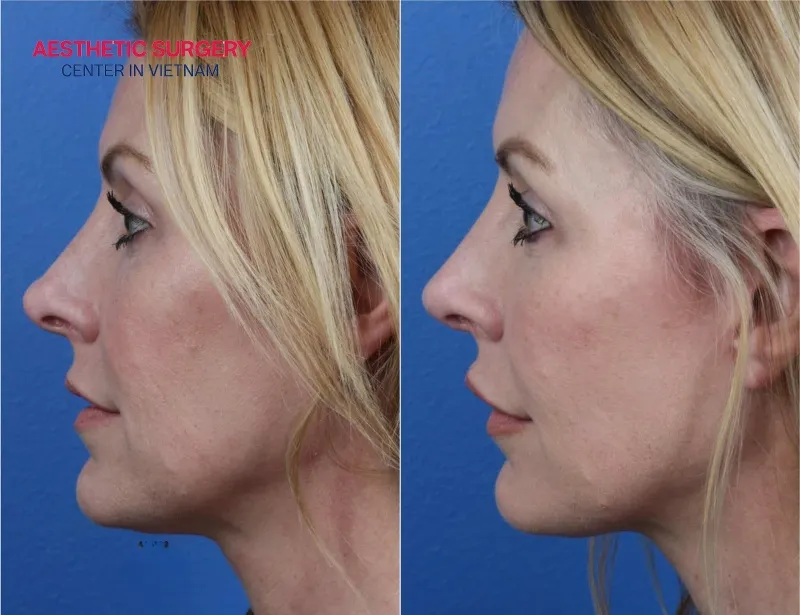
Recovery from revision rhinoplasty
The recovery process after revision rhinoplasty occurs in three main stages, lasting from 3 to 12 months to reach the final result. Although more complex than a primary rhinoplasty, modern technology in Vietnam helps reduce swelling by 50–70%, allowing you to return to normal activities after about one week.
Below are the specific recovery stages:
Stage 1: First 3 days
Right after surgery, you will stay in the hospital overnight. You may notice mild swelling of the nose, bruising around the eyes, and soreness at the cartilage donor area (ear/rib), but these are fully manageable with painkillers, antibiotics, and 15-minute cold compresses. A thermoplastic splint is used to stabilize the nasal shape and compression bandages help reduce fluid accumulation.
Stage 2: Days 4–7
Between day 5 and day 7, depending on your recovery progress, the surgeon will remove the thermoplastic splint and external stitches (if any). Swelling will have decreased by about 50–60%. At this stage, you can gently wash your face with saline solution, use cotton swabs to clean nasal discharge, and avoid touching your nose directly.
You can move around and do light work, but should still wear a protective bandage and keep your head elevated at a 30–45° angle when sleeping. If you need to go outside, protect your nose carefully from sunlight and dust, as these can increase the risk of infection.
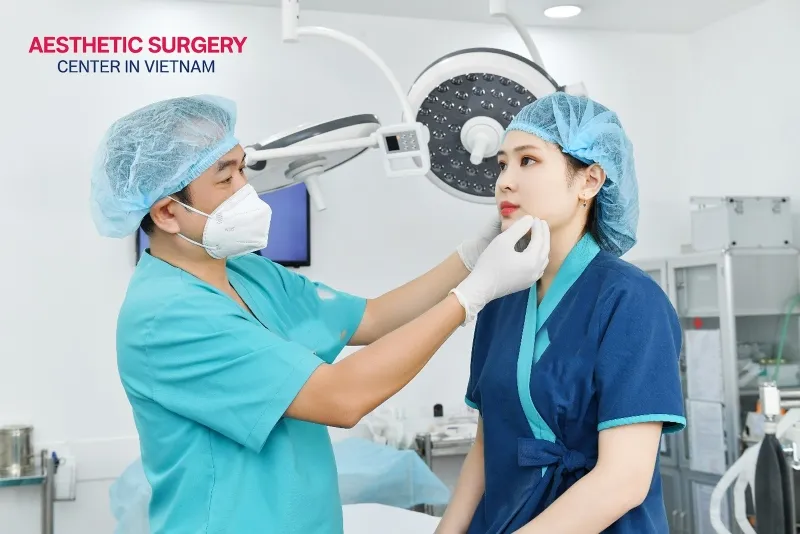
Stage 3: After 1 – 4 weeks
Swelling decreases to about 20–30%, the nasal tip becomes softer, and you can fly back home if you follow the online follow-up schedule. Although recovery is almost complete, you should still avoid intense activities, steam baths, or alcohol. Also, don’t forget to start using scar cream from the second week to prevent keloid formation.
Stage 4: 1 – 6 months
From the second month, the nose looks almost natural, with only slight micro-swelling at the tip. You can resume normal activities, light gym workouts, and swimming from the third month. Scars fade by 80–90%, but continue using silicone gel or Fractional laser treatment to smooth them completely.
Stage 5: After 6 – 12 months
After 12 months, the nose reaches its final result: soft, natural, and free from surgical signs. The autologous cartilage fully integrates, forming a stable structure that resists impact well. You can return to your favorite sports such as gym, swimming, or traveling without worrying about affecting the revision rhinoplasty result or outcome.

Safe revision rhinoplasty address in Vietnam
If you are looking for a safe and reliable revision rhinoplasty clinic in Vietnam, Aesthetic Surgery Center stands out as a top choice, trusted by thousands of international clients for its exceptional quality and care. With a team of experienced surgeons trained at leading aesthetic centers in Asia and Europe, the center ensures precise and highly safe techniques for all cases, from minor structural corrections to complex nasal reconstructions.
After surgery, you will receive dedicated post-operative care in a comfortable recovery room with 24/7 medical monitoring. Our friendly, multilingual consultants accompany you every step of the way, from personalized treatment planning to airport transfers and luxury hotel arrangements, allowing you to relax completely during your recovery.
Revision rhinoplasty is not only a journey to correct imperfections but also an opportunity to achieve a natural, long-lasting, and beautifully balanced nose. With advanced technology, skilled surgeons, and reasonable revision rhinoplasty cost, Vietnam has become an ideal destination for international patients seeking safe and effective beauty enhancement. A well-proportioned nose brings a bright smile and lasting confidence — your transformation journey starts here!






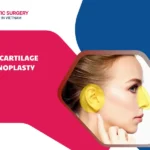
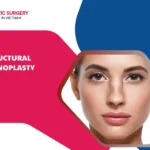





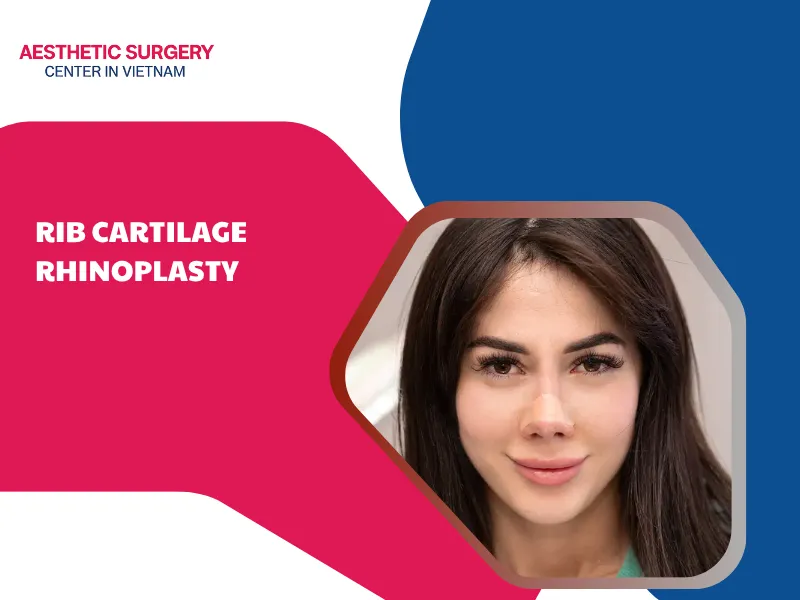

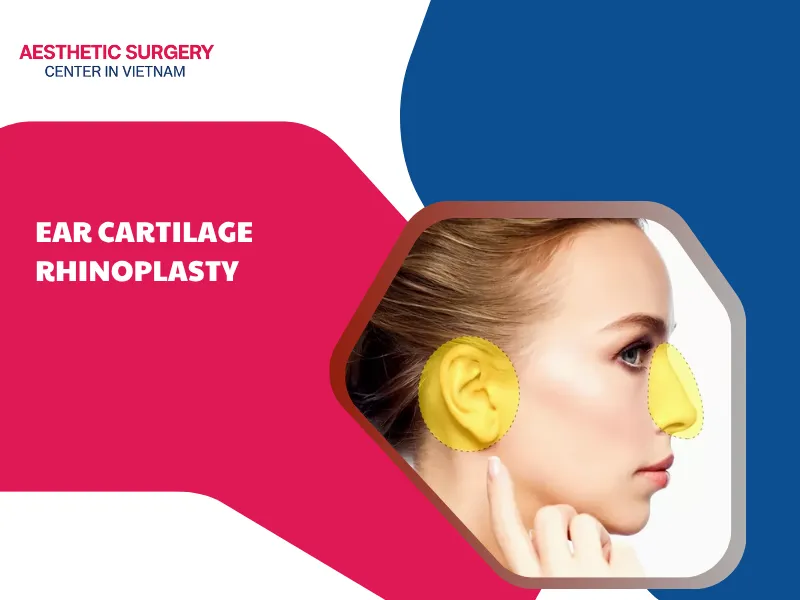




Comment on the post